CHINCHILLAS:
A real alternative to achieve "our own business account" (Independent
entrepreneur)
The Lanigera known chinchilla fur garments or in breeding places,it is an animal that is
extinct in the wild since the late nineteenth century. Its
former natural habitat, Argentina and Chile along Puna, south
of Bolivia and Peru, no longer has species of these
animals. The poaching in those years have completely extinguished
them.
The current generation of
chinchillas exist thanks to what is called THE SUSTAINABLE
RESOURCE . The existence of farms in the hands of
producers who care, nurture and produce skins is feasible
since achieved an income from the sale of the skins of
surplus males.
No income means no farms, and no farms mean no more chinchillas.
A reservation
specially created for this purpose and supported by the
State
could keep some of them, but the reality is that they could not survive more
than a week of life, since they have become accustomed to receiving food
from the hand of man. (We are talking about more than 220
generations -2 x year since 1920)
The hundreds of thousands of
chinchillas that exist today worldwide, expanding year
after year thanks to the existence of breeding sites (the
producer annually expands the number of females in
production and slaughter the male-a surplus males ), it allows for more chins each year nationally
and globally. Otherwise, the nonexistence of breeding places and
the emergence of reserves held by the State would
transform in a few months nearly from 1 million chinchillas
in the world to a few tens of survivors.
Chinchillas Lanígeras population living in the Argentina
Republic
"Wild" Vs. "cattery"
|
|
Chinchillas
from breeding
|
Wild Chinchillas
|
|
Año
|
Quantity aprox
|
Quantity
|
|
1925
|
0
|
0
|
(Declared extinct
wild chinchilla Lanigera)
|
|
1930
|
0
|
0
|
|
1935
|
0
|
0
|
|
1940
|
0
|
0
|
|
1945
|
0
|
0
|
|
1950
|
0
|
0
|
|
1955
|
0
|
0
|
|
1960
|
50
|
0
|
|
1965
|
500
|
0
|
|
1970
|
2.000
|
0
|
|
1975
|
4.000
|
0
|
|
1980
|
8.000
|
0
|
|
1985
|
12.000
|
0
|
|
1990
|
25.000
|
0
|
|
1995
|
50.000
|
0
|
|
2000
|
110.000
|
0
|
|
2005
|
160.000
|
0
|
|
2010
|
220.000
|
0
|
|
2020
|
300.000?
|
0
|
The business venture.
a) How does the profitable activity works?
b) What are the necessary requirements to start in this
activity?
c) What is your income?
d) How is the marketing of production?
e) Who are the ultimate consumers of our product?
These and many more are the most frequent questions that
interested in starting production usually perform.
a) How does the profitable activity works?
Basic Information Required
 |
Low
production costs: A chinchilla eats 25 grams of feed,
a handful of alfalfa and water. It works with polygamous
systems families in which a male serves 4
or 5 females. Gestation is 111 days and they have 4
children per year in two different parities. |
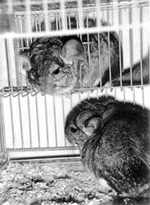 |
Male
and female. It works with polygamous families. The
male has 4 or 5 females for him. The cages are
interconnected through the tunnel or the male corridor.
He moves around and goes down to eat food from their
females or to cover them. There is no need to join them for sex,
they do it alone when they are in heat. |
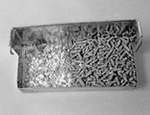 |
A
chinchilla feeder (the plate, 15 cm x 6 cm) with the daily
ration of pellets (balanced pressings cereals are
achieved throughout the country, simile to rabbit), oat, germ and bran, as reinforcement (three times per
week) .
|
 |
Minimum of care: A person can serve 50 animals with
half an hour daily work and up to 800 in 8 hours. |
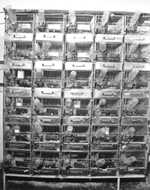 |
Frame of
30 cages (six families of a male and 5 female).Occupies
a space of 1,75mts long, 55cm deep and 2.10 meters high. |
 |
Fluid financial move: At 6 months, both the male
and the female are able to procreate, at 11 months
of age they can be sacrificed (the surplus males).
Remember you require only 25% of males who were
born, the rest will be sold its production).
ARMOTIZATION:
A Chinchilla can live up to 20 years, procreate
until 12 but it works commercially for 7 or 8 years.
Then your skin has a high residual value. - Agile
marketing system without monopolies: The skins are
sold unitarily (thus the producer sells 1, 10, 100
or 1000), and its value depends entirely on the
individual quality of each. We buy live production
or leather since 1964, with a written contract
(single cabin Argentina) given at the time of taking
the animals. |
 |
The breeder
facilities with 3000 skins ready to be sold. |
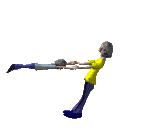 |
The final product
(skin quality)
has a demand much higher than the global supply. (Which
ensures a good business for many years) It's a
venture that does not require constant investment as
working capital (wombs) are increasing year to year |
 |
No veterinary assistance is needed; no pests or
epidemics. The few diseases that can affect are well
known and today, who work with preventive methods,
they can say that there are almost no diseases. |
 |
No need to make large investments in facilities,
local or cages. (You can start in a room, a basement,
a garage or a shed 3 x 3 m. Where you can
accommodate up to 250 animals). The cages are
individual, stackable and take up very little space
(35cm x 35cm x 55cm). The important thing is that
the place is closed, well ventilated and isolated
from the outside temperature. This is why there are
many
chinchillas breeders anywhere in the country, whether in the
cold of Tierra del Fuego, in the heat of Misiones,
in the humidity of the capital or up the mountains in
Mendoza. The cages can be manufactured by the
breeder at very low prices. Obviously if you want
you can purchase the cages manufactured
and standardized. |
 |
Partial view of a
room of 4 x 4 meters with 400 chinchillas. |
 |
Partial view of a room
of 5 x 8 meters with 800 chinchillas. |
| |
|
b) What are the necessary requirements to start in
this activity?
There are five requirements for a Man interested in the
activity to become a breeder of chinchillas for fur
production.
1) Have the capital for the initial investment
in reproductors. From usd 2.000 (the value of a family of one
male and four females with their cages) onwards. You can
start with one, two, 8, 15 or 50 or 200 families. It depends
on each investor capital available
2) Have the premises to accommodate the chins.
(Any closed well ventilated and protected from extreme
temperatures (must have a temperature range throughout the
year between 10 ° and 28 °) is perfectly suited for starting
the activity. The example garage 5 x 3, 3x3 room, the shed,
the barbecue, etc. etc. are in full force and were the
beginning of the breeding sites of large farms today.
3) You must have other activity that will
provide income during the first two years (minimum). It can
be employed, owner, professional, industrial, etc, but the
chinchilla will not grant income until at least 15 months
from the start. There will be capital increase because of
the young chinchillas
that are born, but the first skins are sold when the new
born in the cattery (surplus males) have approximately 10
months old. (If we add the gestation of 111 days, we are
looking
at 15 months)
4) The new interested
breeder has to be pleased with the
treatment of animals. If the interested party does not like
animals of any kind (dogs, cats, or cows, etc.) either
you will like the chinchillas. You will never understand how
the breeding activity works. With chins, there are no
strikes, they eat every day and the
breeder should be well organized to do so. Someone who likes animals
think this point is a nonsense, but we have the experience
of 46 years in the business we know that, depending on the
attractive numbers that throws this export industry, many
people who have no idea on what is animal welfare
and proper treatment of reproductors. We understand that these
points should be clarified from the beginning, even before
venturing deeper into the study of the activity.
5) Patience: Features that the
ineterest breeder
must have because when compared to commercial activity,
breeding chins is much slower, also comparing it with the
Industrial. Compared to other animal production activity it
is very fast (eg. Livestock, equine activity, etc, etc, are
much slower than breeding chins). The trader buys
merchandise in the morning and maybe sells afternoon with a
profit margin, but then 3, 4 or 5 years old, he still is in the
same place, perhaps with more clients but at the same place. Chins
as breeding livestock activity allows exponential growth of
capital giving eating and daily care of chins.
c) What is your income?
The rent is given by the difference in cost of production of
each skin and its selling price.
Within production costs find, food (eat 25 gr. Of food per
day, a bag of balanced feed for chins brings 25 kilos = 1000
servings and costs 45 pesos), the chip (the bed on the tray
where the chin lives) gets changed weekly , marble dust for its two
weekly baths (material highly economical ).
fresh and green alfalfa, Water, A health kit (very little
use, since the chins are not vaccinated, or have pests or
epidemics). Electricity for the environment. (While working
light is on, when it ends off, but may be needed, depending
on location and local conditions, air conditioning for the
summer, leather tanning, etc.
These costs hover at $ 15 per animal including the
proportion of feeding and care of the respective breeding
care of
the animals that are intended for skin.
Sales prices of skins have a value ranging between u $ s 18
and u $ s 70, taking as a real and achievable average for
the good producer of u $ s 40. You can quickly see the
interest income 10 months of work. However it is not the
same u $ s 20 for a skin and u $ s 50.
These price differences for production depend
solely on two factors.
a) The quality of the reproductive parents that gave rise to
those skins: Just as you can not pretend that a marriage of
small height people (husband and wife 1,60mts measures 1.50mts)to
give birth all children of 2 meters high. Nor can two small,
clear with yellow bellies and short haired reproductors to
give
large, dark, long-haired, white belly fur
The genetics of the initial players definitely set the
course of breeding in the future. If you started with cheap
breeding reproductors of people leaving the activity (just
because their skins do not get income), the inevitable end will be the same as those
who sold
them. (Only to be a couple of years later)
Instead, someone who begins with a recognized serious cabin that
exposes all it's years in the exhibitions of major chins (such
as the Rural Society Argentina or Argentina Breeders
Association Chinchillas) surely receive the international
quality needed in reproductor to then get skins according to the
requirements of the international market. That is: Dark,
dense Large, white bellies, absent a reddish gray tints, and own unique silkiness of these animals.
b) Poor performance of the minimum tasks involved in
chinchilla breeding, by the breeder. Nothing has been
invented against Neglect,
inefficiency and lack of compliance with the obligations of
the entrepreneur, yet. There is
a definite parallel between those who buy good reproductors in
serious cabins and works good as a producer and there is the
one who buys "Used" breeding and as not seeing results,
he starts
to neglect his breed. A good product (good skin) can be
ruined by repeated failures in chip changing in the animal's cage (it's
a weekly change). Dirty and wet chip can no longer absorb
rust and stain from the skin. The same applies to farms with poor
ventilation and overcrowding. Finally and foremost it is
necessary to clarify that who learns from good sources (serious
cabins) hardly commits such errors.
 |
 |
|
Chinchilla
first International Quality. Great, Densiy, Dark,
bulled,
Longhair, and veiling coverage,
without brown stains, |
Chinchilla not suitable for
production activity
Chinchilla fur is wooly, mousy, light, shorthair, |
| |
|
 |
 |
Premium
leather from players of international quality (only
findable in serious Cabins with seniority and
experience)
(Animal photo above) |
Poor quality skin from
Chinchillas unfit for fur production quality.
(Animal photo above) |
| |
|
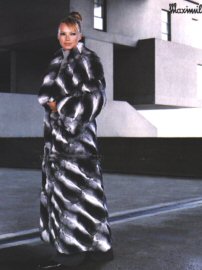 |
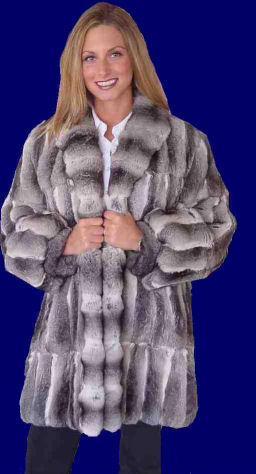 |
|
Garment made
from the skins of international quality. Sublime,
exotic and the pledge of the world world's most
expensive fur. Chinchilla fur. |
Chinchilla wearing sleazy,
trimmed, dyed and sold to a sector of the population
of much less purchasing power than the true quality
garments chinchilla and natural color. |
d) How is the marketing of production?
The marketing managers chinchilla skins worldwide are
called assemblers.
They are the ones who make it possible for a small
skin producer that lives in a village of 1000 inhabitants
to 1000 km. of a major city, to reach a piece of high couture and
to be sold in Elissee Champs in Paris at higher
prices than $ 50,000.
The work of these collectors is divided into two parts:
- Buying to the breeder.
There are many collectors of skins of chinchillas in the
world, and are of different nationalities. Whose job is to
address all those cities where they can get a reasonable
amount of skins and publicly buy skin by skin comparing patterns
Chinchillas Eldorado is responsible for studying and
informing farmers about the options available according to
the annual calendar. It is chosen for a reason for payment,
price, security, backup, distances, etc. Long before the
sale becomes effective, all customers from Chinchillas Eldorado
will be informed about where, when and with whom the public
sale of skins are made.
In 90% of cases they are planned for the weekend, so nobody
is left out because of labor problems. The day of the sale
there will be a table for graduation in order
to value the skins (exactly like we use in the cabaña to
examine our animals) and other tables so that producers can
give their last combed skins before selling.
On the table, the gatherer will compare patterns. We are
talking about
skins with different qualities and sizes. Generally there are
ten skins on the table each with its label with the dollar
value. So there will be skins for u $ s 10, $ s20, $
s30, $ s40, $ s50, $ s60, $ s70, $ s80, $
s90 and US $ 100. The differences will be perfectly visible
even
for the inexperienced breeder. The
first will be smaller, lighter and more flat, rising in
size, color, long hair and others, as they raise their
prices.
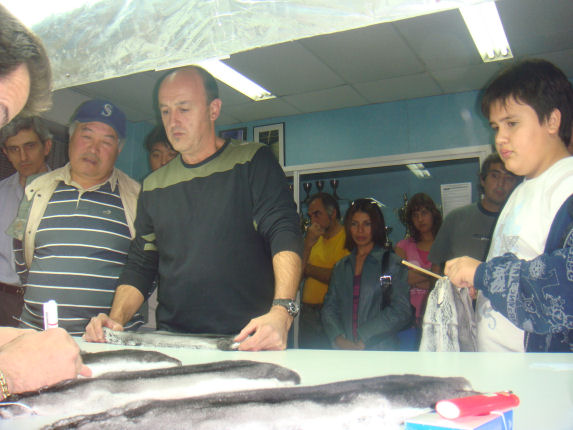 |
The buyer in one side of the table with
comparison patterns.
Note the price tag with the preset patterns. |
| |
|
 |
Skin by skin,
comparing on one side
the buyer and his assistant, the other side hundreds of
producers waiting their turn |
| |
|
 |
Note that the rest of the breeders who have not
yet sold their skins can jointly observe what is
happening at every moment. How is he paying? What
is rewarded? What is punished? What is taught? |
| |
|
 |
You learn from the successes and mistakes
from yourself and others. The good producer does not
repeat mistakes |
| |
|
 |
Participating in a sale of skins; security,
transparency to the commercial act of selling the
final product. |
Everything is ready for the first producer to start selling
openly and publicly. The producer will deliver the first
skin to the gatherer, who will then place it in the middle of the two most
similar of his. Differences and similarities are
clear. In no case skin or $ 50 may be located in the middle
of u $ 10 or $ 20 u, as the producer and the rest of
breeders would retire at the same time. And the gatherer
who traveled to the place, paid all his living expenses
and per diem will return to his country without the skins he
came for. (And note that Argentina is not exactly in the
center of the planet)
Gatherer will speak loudly the prices, giving corresponding
explanations for each case and each skin. Example ... "This
skin worth $ s56 or because it is darker and bigger than u $
s50 but does not reach u $ s60 because the hair should be a
little longer" ....
The producer can say Ok (which sells) or NO (not sell). Both
the first and second case, continue with the next skin. The
price is not negotiable and it is only based on the quality of each
skin. (The gatherer writes the price of the skin in the leather
and when completed the sale, all the skins of this first
producer shall be detailed on one sheet (today is done by computer)
with the value corresponding to each tag or skin, the amount, and the
total value to be paid.
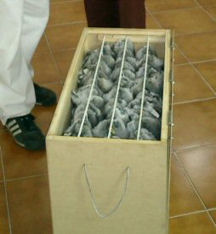 |
 |
|
Producers come to the
table with their monthly production to be sold
skin by skin as a unit. Each manages an efficient and
economical transportation way to move the skins from
their farm to the places of Public Sales |
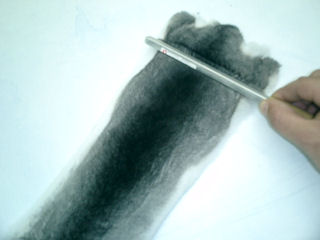 |
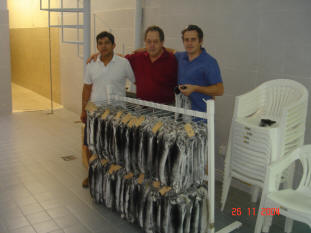 |
|
The presentation, the
last touch of combing and grooming of fur gives them
an added value at the time of its listing. |
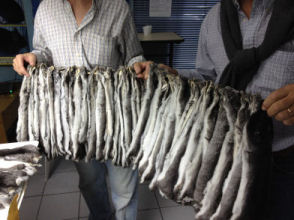 |
 |
The good breeder, hardworking and with good quality of
reproductors is guaranteed success.
|
Payment is at the same time, cash or check to the day, usually the
latter becase of a security issue. Remember that the skin will
offer identification tag, it is a closed metal sealed with
a special clip that renders inviolable, as will be cut to
open if tryed to break it. Each precinct will have a
multi-digit number and can be signed by the breeder himself.
This tag or seal is placed just before being sent to the tannery and
it has several reasons. First it serves us to individualize the
skin and know what animal it comes from, and second, so
in no case it can get lost or confused in the tannery since the
numbering individualizes the
owner.
The interesting thing about this system, besides being
crystalline, is its educational part. Every good gatherer
spends time explaining to each producer, genetics and
management of their skins deficiencies. The observer breeder never repeats errors.
Sometimes the buyer loses half hour valuing 20 skins to a
small producer and sometimes longer too. But he knows what
he teaches will be very well received by the producer, if he
is
diligent, next time he will have more and better skins. Usually
the meticulous breeder who learns from the teachings of a
gatherer, becomes a loyal customer of the same. THIS LAST IS
WHAT CARES, Gatherers NEED OF OUR SKINS AND NOTHING BETTER
THAN SAFE AND CONTINUESLY lIN MANY GUESTS SKINS of good
quality.
Chinchilla fur producers are people of the most
diverse areas, genders, ages and professions that one can
imagine
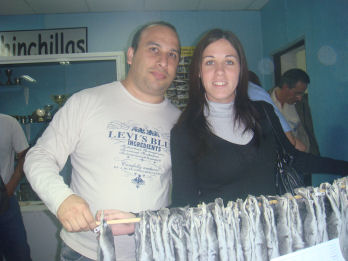 |
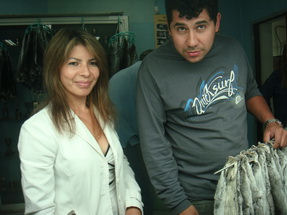 |
|
Young couples |
Professionals of all kinds: engineers, lawyers,
accountants, architects, etc, etc. |
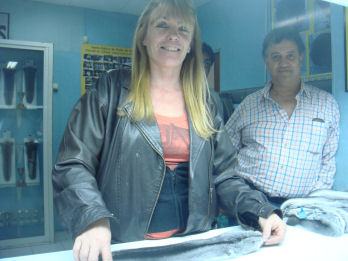 |
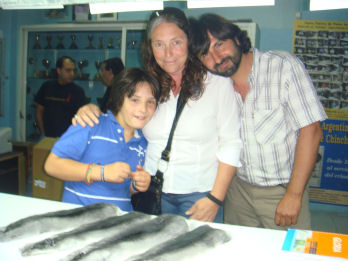 |
|
single woman |
Couples with children |
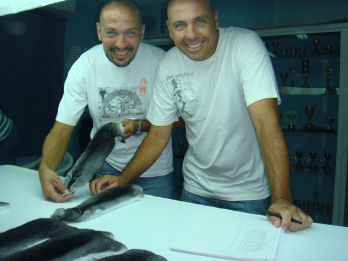 |
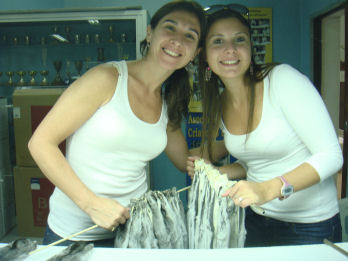 |
|
Siblings companies |
|
 |
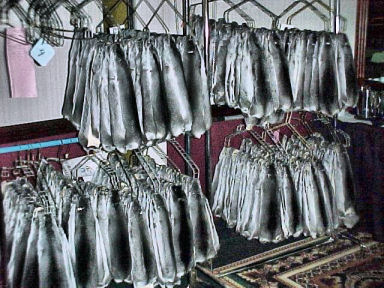 |
|
Mothers with
daughters |
large companies that want to
diversify their income |
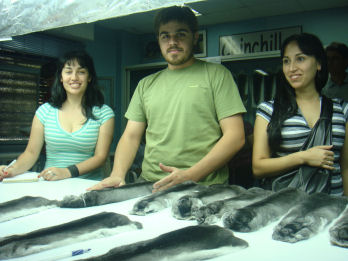 |
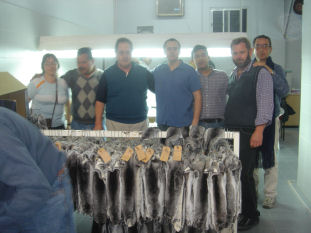 |
|
Many young
people |
investment group |
When the seller is a former breeder, sometimes selling is so
fast that he can buy up to 500 skins in half an hour, since
both (the gatherer and the old producer) know at a glance
the value it deserves every skin.
Dr. Fernando Aleandri
Commission Directive Member
Argentina Association of Breeders of Chinchillas
A.A.C.Ch.
Venezuela 3956 (1211)
Federal capital
Tel 005411 491-0034 (rotating lines)
www.chinchilla.com.ar/asoc.htm
asoc@chinchilla.com.ar |
|


